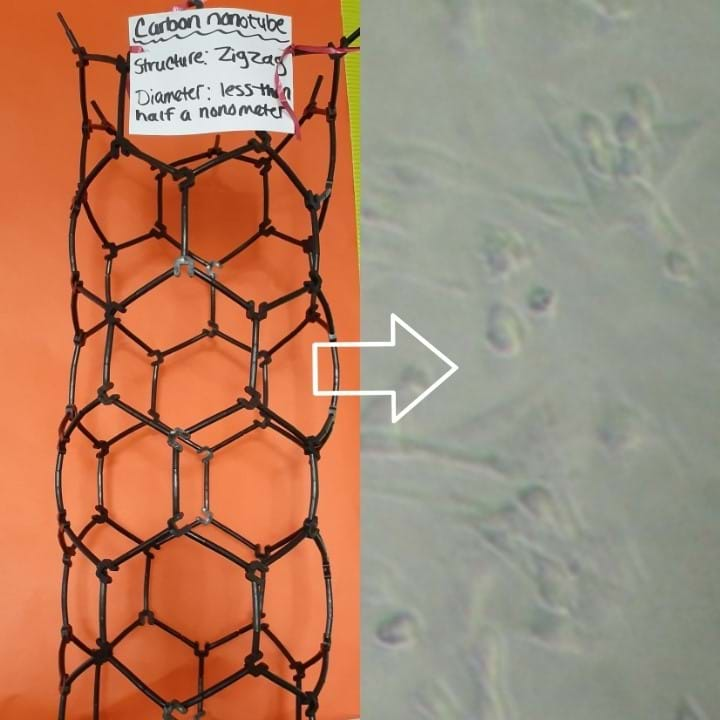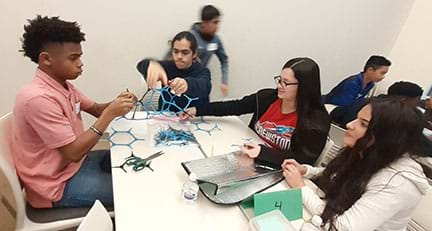Quick Look
Grade Level: High school
Time Required: 3 hours (wild guess!)
Subject Areas: Biology, Chemistry, Science and Technology

Maker Challenge Recap
This engineering challenge immerses students into the science fields of nanotechnology, biology, chemistry, technology and biomedical studies. Students explore the growing world of carbon nanotubes and their current impact to detect and diagnose breast cancer. Working in groups of four, students design a new and improved carbon nanotube.
Students begin by brainstorming and designing a structure that entails 100 carbon nanotube mini pieces per group. Students then have to select household materials that works best as heat conductors and applies them to their carbon nanotube structure. Once carbon nanotubes structure designs are complete, students test the thermal conductivity of models by using thermal conductivity guns. Models then sit under a heating lamp for three intervals of 10 minutes. When 10 minutes has lapsed for each interval, students gather their models and collect measurements of their structures using thermal guns. From there, students analyze data and think-pair-share on ways they can improve their carbon nanotube model.
Maker Materials & Supplies
- An assortment of materials that work as conductors, semiconductors, or insulators such as: aluminum foil, rope, wax paper, metal washers, plastic wrap, paper bags, pennies, tin pans, duct tape, black paper, white paper, twine, bubble wrap, etc.
- An assortment of materials to build, decorate, and test student designs such as: scissors, paint, glue, glue gun, markers, tape, colored paper, heating lamps (between 5-6), about 100- 200 carbon atom pieces per group to build a carbon nanotube structure (see Resources for purchasing options), and a non-contact digital thermometer guns.
- A complete carbon nanotube model (see Resources for building directions)
Worksheets and Attachments
Visit [www.teachengineering.org/makerchallenges/view/rice2-2502-nanotube-breast-cancer-design-challenge] to print or download.Subscribe
Get the inside scoop on all things TeachEngineering such as new site features, curriculum updates, video releases, and more by signing up for our newsletter!Kickoff

Do you know of anyone who has cancer? Discuss with your partner for one minute on your experience with cancer and express the way it makes you feel. My next question is what is cancer? (Have students quickly jot down their definitions or draw their understanding of cancer; use the New and Improved Carbon Nanotube Presentation to conduct the maker challenge.)
Cancer is a disease which is caused by uncontrolled cell division that can take place in any part of the body. Breast cancer in particular is cancer that forms in the breast. Breast cancer happens to be the 2nd most common cancer that is diagnosed in women in the United States. Are men exempt from this disease? The answer is no, men are also very capable of developing breast cancer as well; they just develop it at a lower rate than women.
Now, I know that it is common that most have heard of breast cancer, but what about the terms nanotechnology and carbon nanotubes? Look up both words online and then write two sentences on how you believe these two terms may have any relevance to breast cancer. (Once students finish, play the YouTube video, “Nanoparticle drug delivery in cancer therapy”- https://www.youtube.com/watch?v=emEua2eJp1U).
(Explain carbon nanotubes by showing a model and show how carbon nanotubes have optical properties such as thermal conductivity which plays a huge role in detecting and diagnosing breast cancer. To help explain this, shows the following videos on electrical conductivity https://www.youtube.com/watch?v=QZPURSF5iH4 thermal conductivity and thermal resistance https://www.youtube.com/watch?v=fXjzqbRdR8g).
For this challenge, you are taking on the role of an engineer who must create a new and improved carbon nanotube which must hold high optical properties of thermal conductivity over 150.0 W/mK and electrical conductivity measured at 180 W/mK. These higher levels of thermal conductivity are factors that allow doctors to effectively detect or diagnose breast cancer. Working in a team of four, you will brainstorm how you would like to build your carbon nanotube model. (Students will use the CER Nanotube Worksheet to collect information.) Quickly build your carbon nanotube and then use prior knowledge of conductivity to figure out which household items are most appropriate to apply on your models. You may also conduct further research if needed. Once your team has developed a game plan, you are ready to construct.
Let the mission begin!
Resources
Site to purchase carbon nanotube structure pieces:
https://www.molecularvisions.com/molecular-model-parts/framework-model-parts/cat_4.html
Building an example carbon nanotube model: Connect 120° carbon atom pieces together to form hexagons. Then, begin connecting hexagons together to form a sheet. Fold this sheet into a tube shape and connect the sides so that one, long carbon nanotube is formed (see Image 1 as an example).
Maker Time
- Engage students and review concepts behind cancer by using the New Improved Carbon Nanotube PowerPoint Presentation. (A video on slide 2 will help show the cell cycle and cancer growth.)
- Inform students about the relation of nanotechnology and breast cancer. Next go over vocabulary in relation to electrical and thermal conductivity (See slide 7 in the PowerPoint Presentation along with videos in the Kickoff: https://www.youtube.com/watch?v=QZPURSF5iH4 and https://www.youtube.com/watch?v=fXjzqbRdR8g.)
- Divide students into groups of 3-4. Give students 12-15 minutes to brainstorm how they want to construct their carbon nanotube model. Students should agree on what household items will give their model the best electrical and thermal conductivity measurements.
- During brainstorming, students show an example of a carbon nanotube to help prompt and accelerate the building process.
- After brainstorming students should begin building for about 25-30 minutes. Once the structure is complete, students select a household material that they believe will hold the most thermal conductivity. Students will then measure the conductivity initial results by using a thermal gun.
- Students will then place structures under a heating lamp for 10 minutes. While waiting on carbon nanotube structures, students will further research on the topic and begin to develop inquiry based developed questions about how carbon nanotubes relate to cancer treatment.
- After 10 minutes, students will measure the final temperature of their structures using the thermal gun. Teams will then analyze results and hold discussions on how they can improve their model and thermal conductivity. Teams will select another household product that will best improve their structure. Initial temperature of structure will be taken, and structures will be placed back under heating lamps for another 10 minutes. Have students repeat steps 6-7 for a total of 3 times and record data on the CER Nanotube Worksheet.
- Teams will then display results and findings on a large sheet of poster paper. (Optional: groups will then clean up and sit their posters on counters along with models for preparation of a gallery walk.)
Wrap Up
Students will reflect on their design and results. Teams will communicate their design process on a large sheet of poster paper. Students will place models and poster papers around the room counters. Students will rotate in teams to visit other group findings and must include a positive comment as well as a take-away from each teams’ poster and structure.
Tips
Teachers will find it helpful to follow the attachments.
Copyright
© 2020 by Regents of the University of Colorado; original ©2019 Rice UniversityContributors
Shamial Allen; Sima TannerSupporting Program
Engineering Research Center for Nanotechnology Enabled Water Treatment System (NEWT) RET, Rice UniversityAcknowledgements
This maker challenge was developed in collaboration with the Rice University Office of STEM Engagement, based upon work supported by the National Science Foundation under grant number. EEC-1406885- Nanotechnology Research Experience for Teachers at Rice University, Houston, TX. Any opinions, findings, and conclusions expressed in this maker challenge are those of the authors and do not necessarily reflect the views of the National Science Foundation.
This maker challenge was best inspired by the 2019 NSF summer research program and exposure to research conducted in the laboratory of Dr. Bruce Wiseman laboratory (George R. Brown and Chemistry, Rice University). I would like to thank the Wiseman Group for all their meaningful support and insight geared toward my summer research in nanotechnology. Special thanks to Isaias Cerdas and Christina Crawford for their guidance within the RET program as well as their encouragement geared towards lesson planning.
Last modified: September 15, 2020





User Comments & Tips